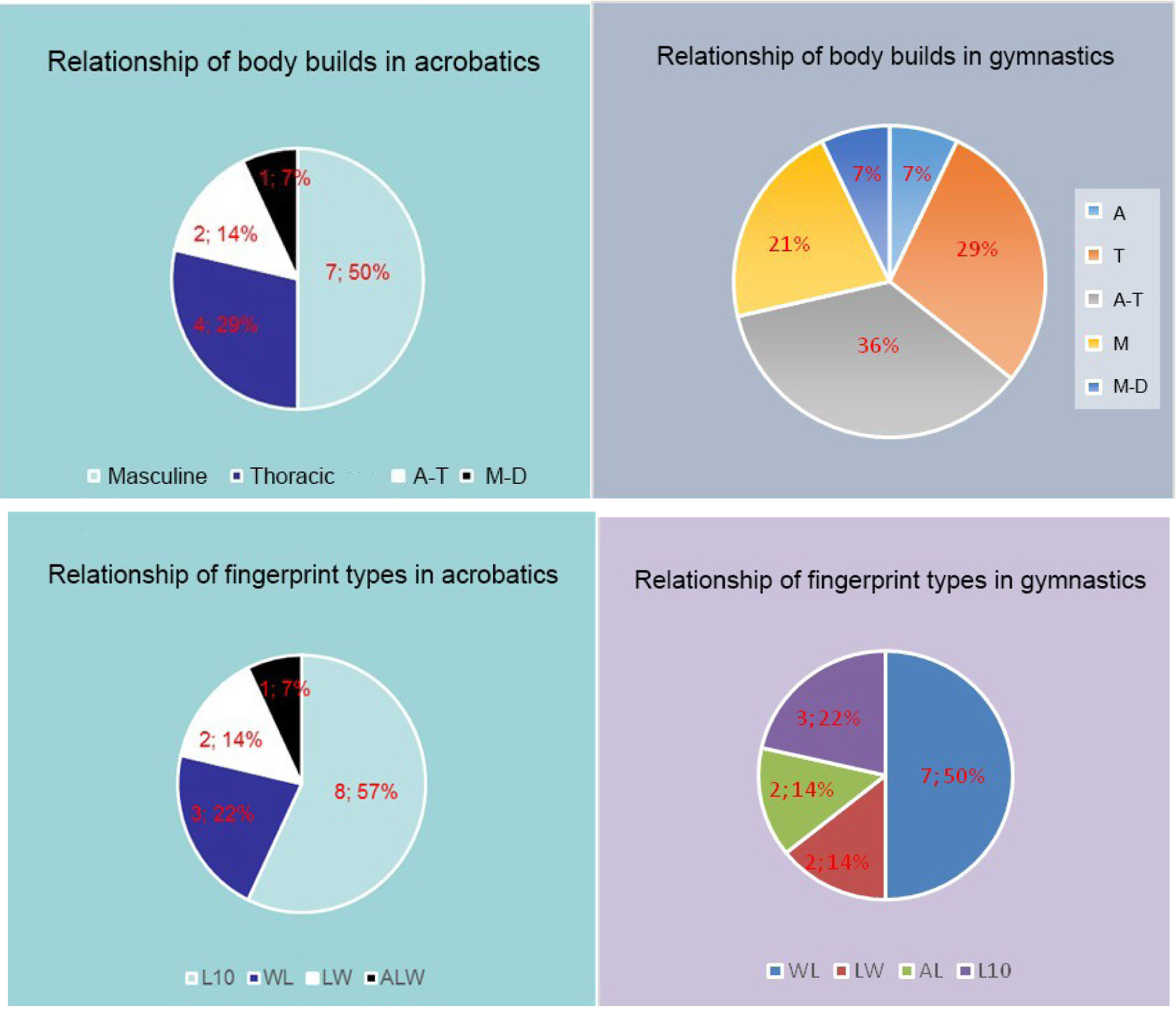Dominating body builds versus fingerprints analyzing method to identify prospects in artistic gymnastics
Фотографии:
ˑ:
Dr.Biol., Professor R.V. Tambovtseva1
Master’s student A.V. Zagorskaya1
1Russian State University of Physical Education, Sport, Youth and Tourism (GTSOLIFK), Moscow
Keywords: artistic gymnastics, sport acrobatics, body build, dermatoglyphycs, fingerprints, physical qualities, coordination ability, flexibility, speed-strength qualities.
Introduction. In complex coordination sports, successful performance largely depends on the level of development of the basic motor abilities: coordination, flexibility, speed-strength and strength abilities, endurance. The methodological base for both sports is quite informative. Coaches normally know which motor abilities and at what stage of the training process play a dominant role [2-4]. However, not all athletes are able to achieve high results when developing certain physical qualities. Therefore, a key aspect of selection is the identification of the most genetically gifted athletes within a particular sports activity. Among the most promising markers that reveal the necessary physical parameters are dermatoglyphycs (fingerprints) and individual typological features of body build.
Objective of the study was to determine and compare the individual typological features of dermatoglyphics and body build in female athletes engaged in artistic gymnastics and partner-team sport acrobatics.
Methods and structure of the study. The study was carried out at the Muscular Activity Bioenergetics Laboratory of the Sport Biochemistry and Bioenergetics Department named after N.I. Volkov; and every experiment under the study was performed at no risk for human health in compliance with the internationally accepted provisions on humanity and ethical standards as provided by the 2000 Helsinki Declaration and EU Directive 86/609. The subjects agreed to take part in the experiment of their own free will. Subject to tests under the study were highly-skilled female artistic gymnasts and sport acrobats (n=28). At the time of the study, all female athletes were healthy. The tests were designed to obtain their anthropometrical measurements and fingerprints (dermatoglyphic patterns) [1], used to determine their predisposition to all basic physical activities. The data were statistically processed using the Statgraph and MS Excel software packages.
Results and discussion. The study revealed the body build types and fingerprints in each female athlete with the relationship between the dominant types in the groups of artistic gymnasts and sports acrobats examined. The key findings are presented in Tables 1, 2 and in diagrams.
Table 1. Evaluation of individual typological features of dermatoglyphycs and body build in elite gymnasts
|
№ |
Sports category |
Body build |
Dermatoglyphic pattern |
|
1 |
CMS |
Asthenic |
AL |
|
2 |
MS |
Thoracic |
WL |
|
3 |
MS |
A-T |
LW |
|
4 |
MS |
A-T |
WL |
|
5 |
MSIC |
Masculine |
L10 |
|
6 |
MS |
M-D |
WL |
|
7 |
MS |
A-T |
WL |
|
8 |
CMS |
Thoracic |
AL |
|
9 |
MS |
Thoracic |
LW |
|
10 |
MS |
Asthenic |
L10 |
|
11 |
MS |
Thoracic |
WL |
|
12 |
CMS |
Masculine |
WL |
|
13 |
MSIC |
A-T |
L10 |
|
14 |
MS |
Masculine |
WL |
The study found that the most common dermatoglyphic phenotype of the female gymnasts was the WL one, which corresponds to a high level of development of coordination abilities. The girls tested with the L10- (priority development of the speed-strength component) and LW-type (high level of coordination abilities with predisposition to development of endurance) fingerprints can also achieve high results in artistic gymnastics.
The study of somatic and constitutional features found that the predominant body build in the sample was the asthenic-thoracic one, characterized by high speed-strength rates, endurance, relative strength and average balance and flexibility values. The female athletes tested with the thoracic body build demonstrate better balancing ability, while those tested with the masculine and masculine-digestive body types have well-developed flexibility and speed-strength abilities.
Table 2. Evaluation of individual typological features of dermatoglyphycs and body build in elite acrobats
|
№ |
Sports category |
Body build |
Dermatoglyphic patterns |
|
1 |
I senior |
Masculine |
L10 |
|
2 |
I senior |
Thoracic |
L10 |
|
3 |
I senior |
Masculine |
WL |
|
4 |
I senior |
Masculine |
WL |
|
5 |
I senior |
Masculine |
L10 |
|
6 |
I senior |
Thoracic |
L10 |
|
7 |
I senior |
Masculine |
L10 |
|
8 |
CMS |
Thoracic |
L10 |
|
9 |
CMS |
А-Т |
ALW |
|
10 |
CMS |
А-Т |
L10 |
|
11 |
CMS |
M-D |
LW |
|
12 |
CMS |
Masculine |
L10 |
|
13 |
MS |
Masculine |
WL |
|
14 |
MS |
Thoracic |
LW |
The masculine body build was found to be the dominating one among the female athletes involved in sport acrobatics, and the dominating fingerprint type was L10 (speed-strength abilities), which, just like in the previously studied sample of female gymnasts, meets the specifics of the kind of sport and partly confirms the authenticity of the selected genetic markers. The data obtained are most clearly illustrated in the diagrams below.

Conclusions:
- the most common fingerprint pattern in artistic gymnastics is WL, in acrobatics - L10, which meets the "requirements" of these sports and indirectly confirms the applicability of dermatoglyphics as an informative marker of human inclinations for complex coordination sports;
-
the dominating body build in artistic gymnastics is asthenic-thoracic, in acrobatics - masculine;
-
the female athletes tested with the WL, LW and L10-types fingerprints and asthenic-thoracic, thoracic and masculine body builds tend to be successful in both artistic gymnastics and sport acrobatics;
- the female athletes tested with the AL, ALW-types of fingerprints and asthenic and digestive body builds seldom if ever succeed in these sport disciplines;
- when determining the priority groups of elements for each female gymnast, it is necessary to take into account not only the types of fingerprints, but also the quantitative indicators of the total finger ridge count and individual finger ridge count;
-
along with dermatoglyphics it is rational to use the anthropometric measurement method, which is most informative for determining the athletes’ potential for maximum flexibility.
References
- Abramova T.F., Nikitina T.M. Asimmetriya priznakov paltsevoy dermatoglifiki, fizicheskiy potentsial i fizicheskie kachestva cheloveka [Asymmetry of signs of finger dermatoglyphics, physical potential and physical qualities in man]. Morfologiya, 2000, vol. 118, no. 5.
- Korkin V.P. Akrobatika [Acrobatics]. Moscow: Fizkultura i sport publ., 1983, 127 p.
- Lisitskaya T.S. Khudozhestvennaya gimnastika [Artistic gymnastics]. Moscow: Fizkultura i sport publ., 1982, pp. 18-25.
- Semenov L.A. Opredelenie sportivnoy prigodnosti detey i podrostkov [Determination of predisposition to sports in children and adolescents]. Moscow: Sovetskiy sport publ., 2005, pp. 128-132.
Corresponding author: ritta7@mail.ru
Abstract
Both modern artistic gymnastics and sport acrobatics are the highly demanding and complexly coordinated sport disciplines. Progress in sport acrobatics is highly sensitive to not only the coordination abilities as such but also to the individual speed-strength qualities and flexibility rates that are significant too. Subject to tests under the study were highly-skilled female artistic gymnasts and sport acrobats (n=28). The tests were designed to obtain their anthropometrical measurements and fingerprints (dermatoglyphic patterns). The study found that the athletes tested with the WL-, LW- and L10-type fingerprints and asthenic-thoracic/ thoracic/ masculine body builds tend to be more successful in modern artistic gymnastics and sport acrobatics – as opposed to the athletes tested with the AL- and ALW-type fingerprints and asthenic/ digestive body builds that statistically seldom if ever succeed in these sport disciplines.


